Dr. Pepe’s Diploma Casebook: Case 7 – SOLVED!
Dear Friends,
MRI of the heart is now a standard tool in diagnostic imaging. This week, I want to show you an MRI examination of a 62-year-old man with dyspnoea.
Most likely diagnosis:
1. Hypertrophic cardiomyopathy
2. Cardiac amyloidosis
3. Cardiac sarcoidosis
4. None of the above
Findings: Four-chamber (a) and short-axis (b) steady-state free precession cine-MRI images show diffuse thickening of myocardial ventricles (green arrows) and atrial septum (>8 mm) (red arrows), together with pericardial effusion (yellow arrows).
- Thickening of the myocardium can be due to hypertrophic cardiomyopathy (HCM), hypertension, valvular stenosis, or deposition diseases. In acute cardiac sarcoidosis, focal myocardial thickening due to oedema is often seen. In very unusual cases of cardiac sarcoidosis, massive infiltration may lead to diffuse myocardial thickening
- Of these causes, the associated findings of thickened ventricular walls with non-dilated left and right ventricles and mild pleural or pericardial effusion suggest cardiac amyloidosis. Atrial septal enlargement >6mm appears to be specific for amyloid infiltration.
- Final diagnosis: cardiac amyloidosis
The heart is the chest organ most commonly affected by amyloidosis. The myocardium, the atrial septum and atrial walls, the valve leaflets and pericardium can be involved. Increased myocardial wall thickness leads to systolic and diastolic dysfunction, and cardiac arrhythmia.
Delayed contrast enhancement is a frequent finding in cardiac amyloidosis (Fig. 4). Global transmural or subendocardial delayed enhancement is the most common pattern, although suboptimal myocardial nulling and focal patchy areas may also be seen. These findings can occur as an early cardiac abnormality in patients with amyloidosis, even when left ventricular thickness is normal.
In hypertrophic cardiomyopathy, delayed enhancement is usually seen as patchy, bright, intramyocardial areas, related to myocardial disarray and fibrosis (Fig. 5).
Cardiac sarcoidosis in the acute phase is characterised by focal or diffuse enlargement, contraction abnormalities, and increased signal intensity on both T2-weighted images and early and delayed images after gadolinium contrast administration, due to oedema associated with granulomatous inflammation.
In the post-inflammatory, replacement scarring phase of cardiac sarcoidosis, there is delayed enhancement resulting from fibrosis.
Fig. 6 shows a 29-year-old man with a history of pulmonary sarcoidosis who presented with arrhythmia. The septal wall shows delayed intramyocardial contrast enhancement without myocardial thickening (arrows) on T1W inversion recovery sequence obtained 10 minutes after contrast injection. Note enhancement of fibrous tissue in lower lobes of the lung.
Follow Dr. Pepe’s advice:
- Thickened ventricular walls with non-dilated left and right ventricles and mild pleural or pericardial effusion strongly suggest cardiac amyloidosis.
- Atrial septal enlargement >6mm appears to be specific for amyloid infiltration
- Delayed gadolinium enhancement is common and detects interstitial expansion from amyloid deposition
Suggested reading:
- Syed IS, Glockner JF, Feng D, et al. Role of cardiac magnetic resonance imaging in the detection of cardiac amyloidosis. JACC Cardiovasc Imaging. 2010;3:155-64. PMID: 20159642.
- Van Geluwe F, Dymarkowski S, Crevits I, De Wever W, Bogaert J. Amyloidosis of the heart and respiratory system. Eur Radiol 2006;16:2358-65. PMID: 16703313
Case prepared by Rafaela Soler MD
cardiac, diagnosis, EDiR, European Diploma in Radiology, MRI
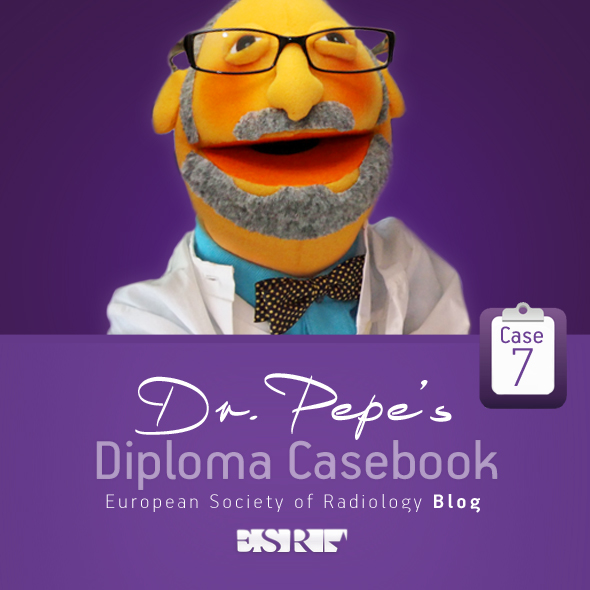
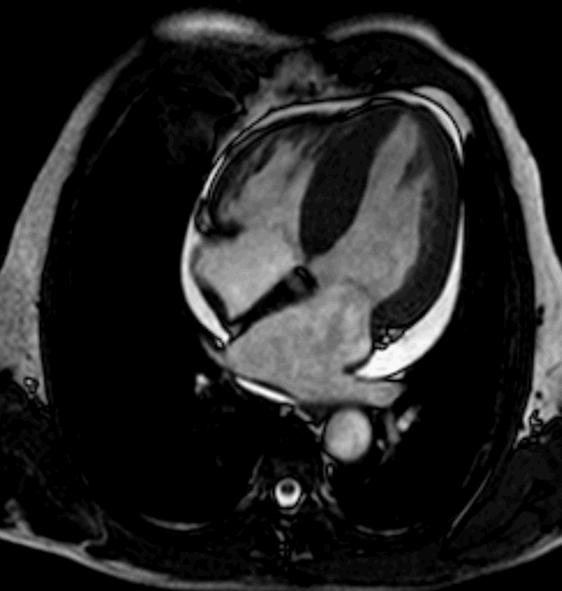
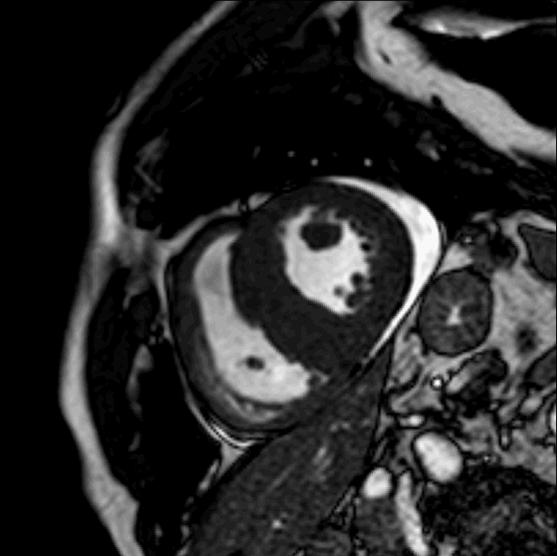

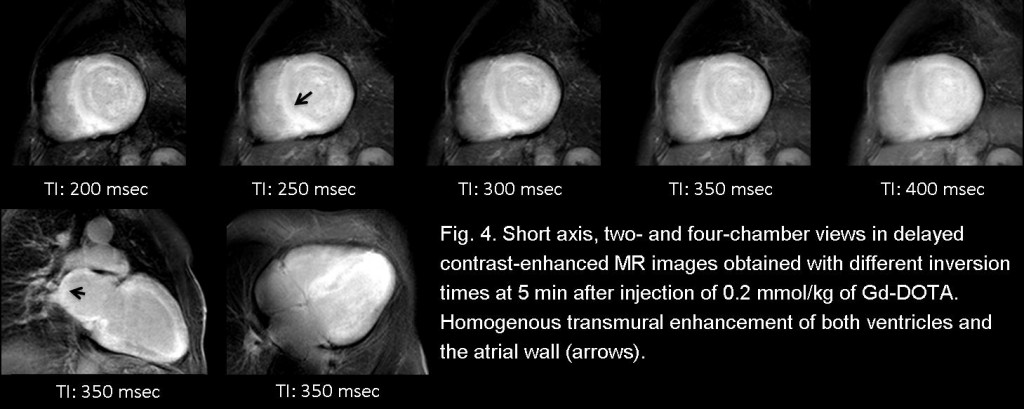
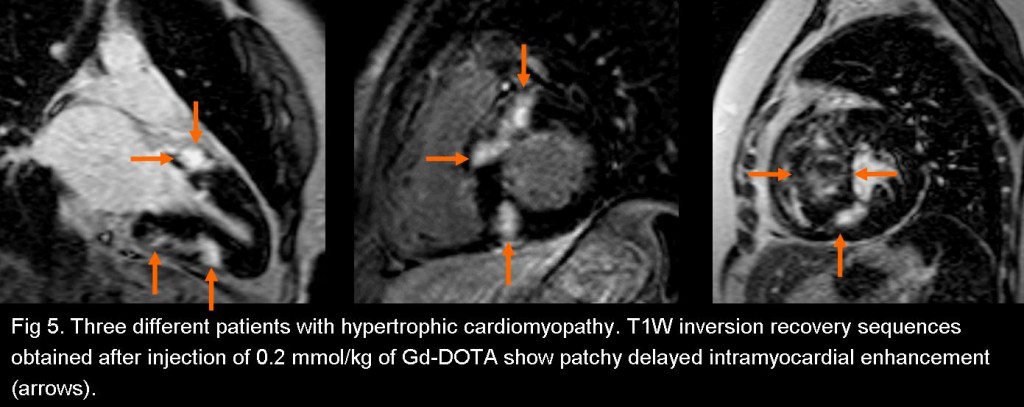




Most conspicuous finding is of a pericardial effusion…HCM, cardiac amyloid are better diagnosed with their specific delayed enhancement patterns on T1+ C sequences: thickened myocardium demonstrating delayed (possibly multifocal hyperenhancement), amyloid demonstrates diffuse (almost all of myocardium is involved) delayed hyperenhancement. In my normal practice, I would take a look at the patient’s CXR to exclude BHL or other features of sarcoid (cardiac sarcoid is a cause of recurrent pericardial effusion) – but common things being common I would have to say that the most likely diagnosis is D. None of the Above and the pericardial effusion is secondary to other causes particularly MI…
T2W SSFP images showing assymetrical thickening of the left ventricular walls predominantly involving the septum(basal septum). the atria are not dilated and show normal wall thickness. the right ventricular wall is normal. based on above findings, my diagnosis will be hypertrophic cardiomyopathy. In amyloidosis, there will be concentric ventricular wall thickening , bilateral atrial enlargement and /or nodular thickening of the atrial wall and interatrial septum(not seen in this case). IN sarcoidosis, there are increased T2 signal intensity foci in thickened myocardium due to inflammation and pericardial involvement-not seen in present case. contrast enhanced images will further help to confirm the diagnosis with different patterns of contrast enhancement in these diseases.
Are you certain that the interatrial septum is not enlarged?
not completely sure but there is no nodular thickening of the interatrial septum and free wall of right atrium.
hypertrophic cardiomyopathy
pericardial effusion
It identifies interventricular septal thickening and pericardial effusion in moderate amounts. To suggest the diagnosis of amyloidosis and sarcoidosis must perform MRI with intravenous gadolinium, to objectify the enhancement pattern taardio infarction in correlation with clinical data.
The diagnosis is hypertrophic cardiomyopathy.
Hypertrophic cardiomyopathy.
Hypertrophic cardiomyopathy (septal) + a small interventricular comunication + Pericardial effusion
Ispessimento della parete ventricolare sx e del setto interventricolare, con riduzione della cavità ventricolare; si associa versamento pericardico.Si esclude pertanto una cardiomiopatia di tipo “restrittivo”(amiloidosi-sarcoidosi-glicogenosi-emocromatosi….).Il reperto depone per una cardiomiopatia di tipo ” ipertrofico”, escludendo, per ovvie ragioni, una miocardiopatia di tipo”dilatativo”.
There is a diffuse wall thickenig of both ventricles that associated to pericardial effusion strongly sugesst us a cardiac amyloidosis, but the late enhancement sequences would be useful to differenciate this entity from hypertrophic cardiomiopaty.
there is a diffuse wall thickening of both ventricles that associated to pericardial effusion strongly suggest us a cardiac amyloidosis. But the late enhancement sequence would be useful to differenciate this entity from others.
Good. You got the point.
Hypertrophic cardiomyopathy.
awesome post for read…i hope everyone enjoy. lista de email lista de email lista de email lista de email lista de email